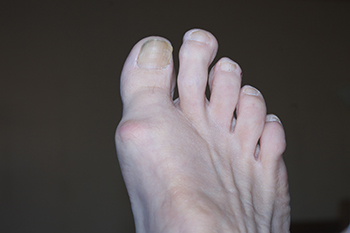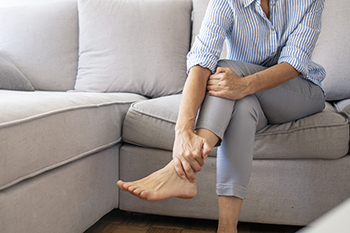Connect With Us
Blog
August 2024

Morton's toe is a hereditary foot condition where the second toe appears longer than the first due to a shorter first metatarsal, which is the bone behind the big toe. This anatomical difference shifts pressure to areas of the foot not designed to bear it, leading to discomfort and various foot issues. Common symptoms of Morton's toe can include pain in the ball of the foot, calluses, and joint instability, which may extend to other areas like the hips or lower back. Relief typically involves non-surgical approaches, such as custom orthotics to redistribute pressure, targeted exercising to strengthen the foot, and footwear adjustments like choosing shoes with a wider toe box. These strategies aim to alleviate pain and improve foot function. In cases where conservative treatments are insufficient, surgery may be considered to correct the bone structure. If you have a painful toe abnormality, it is suggested that you schedule an appointment with a podiatrist for a diagnosis and treatment.
Toe pain can disrupt your daily activities. If you have any concerns, contact one of our podiatrists of Lewis Wolstein, DPM, P.C. & Associates. Our doctors can provide the care you need to keep you pain-free and on your feet.
What Causes Toe Pain?
Most severe toe pain is caused due to a sports injury, trauma from dropping something heavy on the toe, or bumping into something rigid. Other problems can develop over time for various reasons.
Toe pain can be caused by one or more ailments. The most common include:
- Trauma
- Sports injury
- Wearing shoes that are too tight
- Arthritis
- Gout
- Corns and calluses
- Hammertoe
- Bunions
- Blisters
- Ingrown toenails
- Sprains
- Fractures (broken bones)
- Dislocations
When to See a Podiatrist
- Severe pain
- Persistent pain that lasts more than a week
- Signs of infection
- Continued swelling
- Pain that prevents walking
Diagnosis
In many cases the cause of toe pain is obvious, but in others, a podiatrist may want to use more advanced methods to determine the problem. These can range from simple visual inspections and sensation tests to X-rays and MRI scans. Prior medical history, family medical history, and any recent physical traumatic events will all be taken into consideration for a proper diagnosis.
Treatment
Treatments for toe pain and injuries vary and may include shoe inserts, padding, taping, medicines, injections, and in some cases, surgery. If you believe that you have broken a toe, please see a podiatrist as soon as possible.
If you have any questions please feel free to contact our office located in Co-Op City, NY . We offer the newest diagnostic tools and technology to treat your foot and ankle needs.

Distinguishing between a sprained and a broken ankle is important for appropriate treatment. A sprain involves the stretching or tearing of ligaments around the ankle joint, usually caused by an abrupt twist or turn. Symptoms include pain, swelling, bruising, and difficulty moving the ankle, but the joint typically remains intact. Treatment often involves rest and elevation along with over-the-counter pain relief. In contrast, a broken ankle, or an ankle fracture, involves a crack or break in one or more of the bones in the ankle. Symptoms are similar to a sprain but often more severe, with intense pain, significant swelling, bruising, and deformity or inability to bear weight. X-rays are necessary to confirm a fracture. Treatment may involve immobilization with a cast or splint, and in some cases, surgery. If you have ankle pain, it is suggested you contact a podiatrist for an evaluation to ensure proper healing and recovery.
Ankle pain can have many different causes and the pain may potentially be serious. If you have ankle pain, consult with one of our podiatrists from Lewis Wolstein, DPM, P.C. & Associates. Our doctors will assess your condition and provide you with quality foot and ankle treatment.
Ankle pain is any condition that causes pain in the ankle. Due to the fact that the ankle consists of tendons, muscles, bones, and ligaments, ankle pain can come from a number of different conditions.
Causes
The most common causes of ankle pain include:
- Types of arthritis (rheumatoid, osteoarthritis, and gout)
- Ankle sprains
- Broken ankles
- Achilles tendinitis
- Achilles tendon rupture
- Stress fractures
- Tarsal tunnel syndrome
- Plantar fasciitis
Symptoms
Symptoms of ankle injury vary based upon the condition. Pain may include general pain and discomfort, swelling, aching, redness, bruising, burning or stabbing sensations, and/or loss of sensation.
Diagnosis
Due to the wide variety of potential causes of ankle pain, podiatrists will utilize a number of different methods to properly diagnose ankle pain. This can include asking for personal and family medical histories and of any recent injuries. Further diagnosis may include sensation tests, a physical examination, and potentially x-rays or other imaging tests.
Treatment
Just as the range of causes varies widely, so do treatments. Some more common treatments are rest, ice packs, keeping pressure off the foot, orthotics and braces, medication for inflammation and pain, and surgery.
If you have any questions, please feel free to contact our office located in Co-Op City, NY . We offer the newest diagnostic and treatment technologies for all your foot care needs.

Cracked heels can be more than a cosmetic concern, they may signal underlying nutritional deficiencies. Vitamins play a vital role in maintaining healthy skin and preventing such issues. Vitamin A, essential for skin repair and cell turnover, helps prevent dryness and cracking. A vitamin deficiency can lead to rough, flaky skin on the feet. Vitamin E is known for its antioxidant properties and its ability to promote skin healing and hydration, so low levels can impair the skin's ability to recover from damage. Vitamin C is vital for collagen production, which supports skin elasticity and strength. Insufficient Vitamin C can result in weakened skin prone to cracks and splits. Ensuring a balanced diet rich in these vitamins can help maintain healthy, smooth heels and prevent cracks. Cracked heels can be unsightly, and sometimes painful if fissures develop. If you have troublesome cracked heels, it is suggested that you consult a podiatrist for treatment suggestions.
Cracked heels are unsightly and can cause further damage to your shoes and feet. If you have any concerns, contact one of our podiatrists from Lewis Wolstein, DPM, P.C. & Associates. Our doctors can provide the care you need to keep you pain-free and on your feet.
Cracked Heels
Cracked heels appear unappealing and can make it harder for you walk around in sandals. Aside from looking unpleasant, cracked heels can also tear stockings, socks, and wear out your shoes. There are several methods to help restore a cracked heel and prevent further damage.
How Do You Get Them?
Dry skin is the number one culprit in creating cracked heels. Many athletes, walkers, joggers, and even swimmers suffer from cracked heels. Age and skin oil production play a role to getting cracked heels as well.
Promote Healing
Over the counter medicines can help, especially for those that need instant relief or who suffer from chronic dry feet.
Wear Socks – Wearing socks with medicated creams helps lock in moisture.
Moisturizers – Applying both day and night will help alleviate dryness which causes cracking.
Pumice Stones – These exfoliate and remove dead skin, which allows for smoother moisturizer application and better absorption into the skin.
Change in Diet
Eating healthy with a well-balanced diet will give the skin a fresh and radiant look. Your body responds to the kinds of food you ingest. Omega-3 fatty acids and zinc supplements can also revitalize skin tissue.
Most importantly, seek professional help if unsure how to proceed in treating cracked heels. A podiatrist will help you with any questions or information needed.
If you have any questions, please feel free to contact our office located in Co-Op City, NY . We offer the newest diagnostic and treatment technologies for all your foot care needs.

Arthritis, an inflammation of the joints, can cause pain and stiffness. One joint that frequently becomes affected is the big toe, which by throwing off your balance can affect other body parts. One way to help alleviate this syndrome is by doing simple exercises for the toe. Among them is the toe pull, which helps to increase mobility. Put your affected foot on a stool or chair. With one hand, hold the area where the toe meets the foot. With the other hand, gently pull the toe forward and flex it down for 10 to 20 seconds then let go. Repeat. Toe salutes are designed to stretch and build strength. Sit in a chair with your feet flat on the ground directly below the knees. Raise the big toe of one foot up, while the other toes remain flat. Hold for five seconds and relax. Then raise the four little toes up, while keeping the big toe flat. Repeat, and then change feet. If you plan to begin any exercise regime, it is suggested you consult with a podiatrist who can monitor your activity and suggest other treatment options.
Arthritis can be a difficult condition to live with. If you are seeking treatment, contact one of our podiatrists from Lewis Wolstein, DPM, P.C. & Associates. Our doctors can provide the care you need to keep you pain-free and on your feet.
Arthritic Foot Care
Arthritis is a term that is commonly used to describe joint pain. The condition itself can occur to anyone of any age, race, or gender, and there are over 100 types of it. Nevertheless, arthritis is more commonly found in women compared to men, and it is also more prevalent in those who are overweight. The causes of arthritis vary depending on which type of arthritis you have. Osteoarthritis for example, is often caused by injury, while rheumatoid arthritis is caused by a misdirected immune system.
Symptoms
- Swelling
- Pain
- Stiffness
- Decreased Range of Motion
Arthritic symptoms range in severity, and they may come and go. Some symptoms stay the same for several years but could potentially get worse with time. Severe cases of arthritis can prevent its sufferers from performing daily activities and make walking difficult.
Risk Factors
- Occupation – Occupations requiring repetitive knee movements have been linked to osteoarthritis
- Obesity – Excess weight can contribute to osteoarthritis development
- Infection – Microbial agents can infect the joints and trigger arthritis
- Joint Injuries – Damage to joints may lead to osteoarthritis
- Age – Risk increases with age
- Gender –Most types are more common in women
- Genetics – Arthritis can be hereditary
If you suspect your arthritis is affecting your feet, it is crucial that you see a podiatrist immediately. Your doctor will be able to address your specific case and help you decide which treatment method is best for you.
If you have any questions, please feel free to contact our office located in Co-Op City, NY . We offer the newest diagnostic and treatment technologies for all your foot care needs.
Blog Archives
- 2025
- 2024
- 2023
- 2022
- 2021

